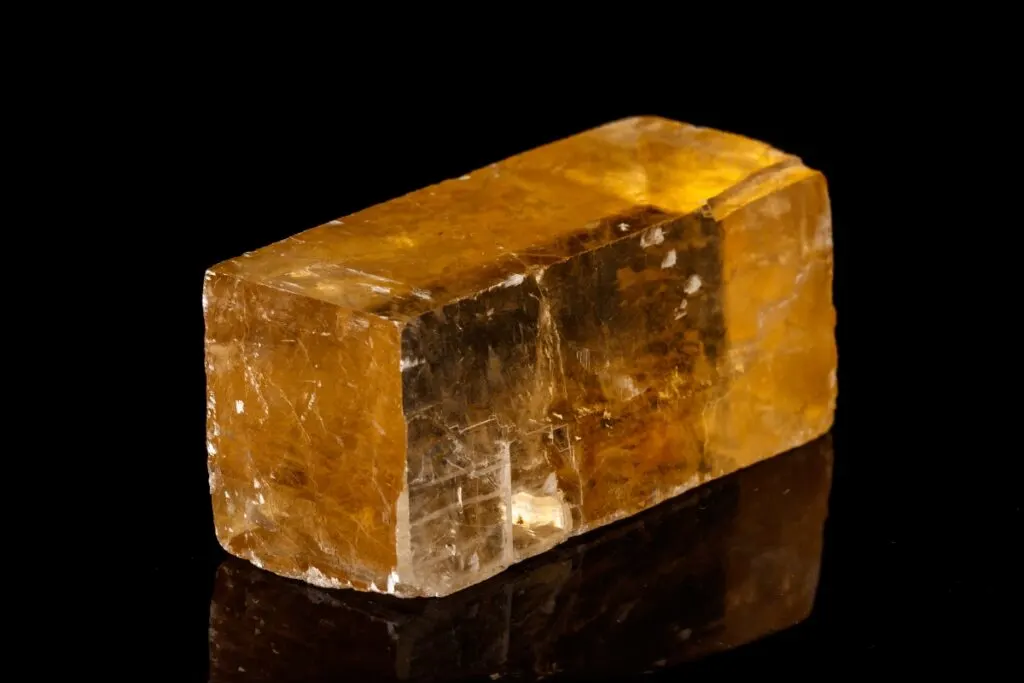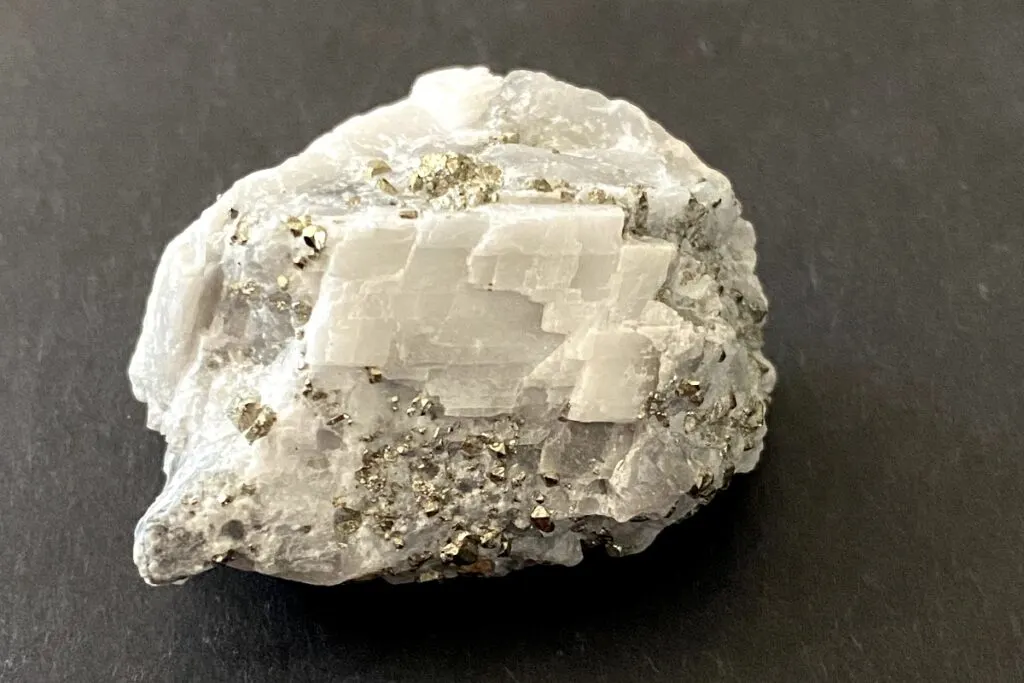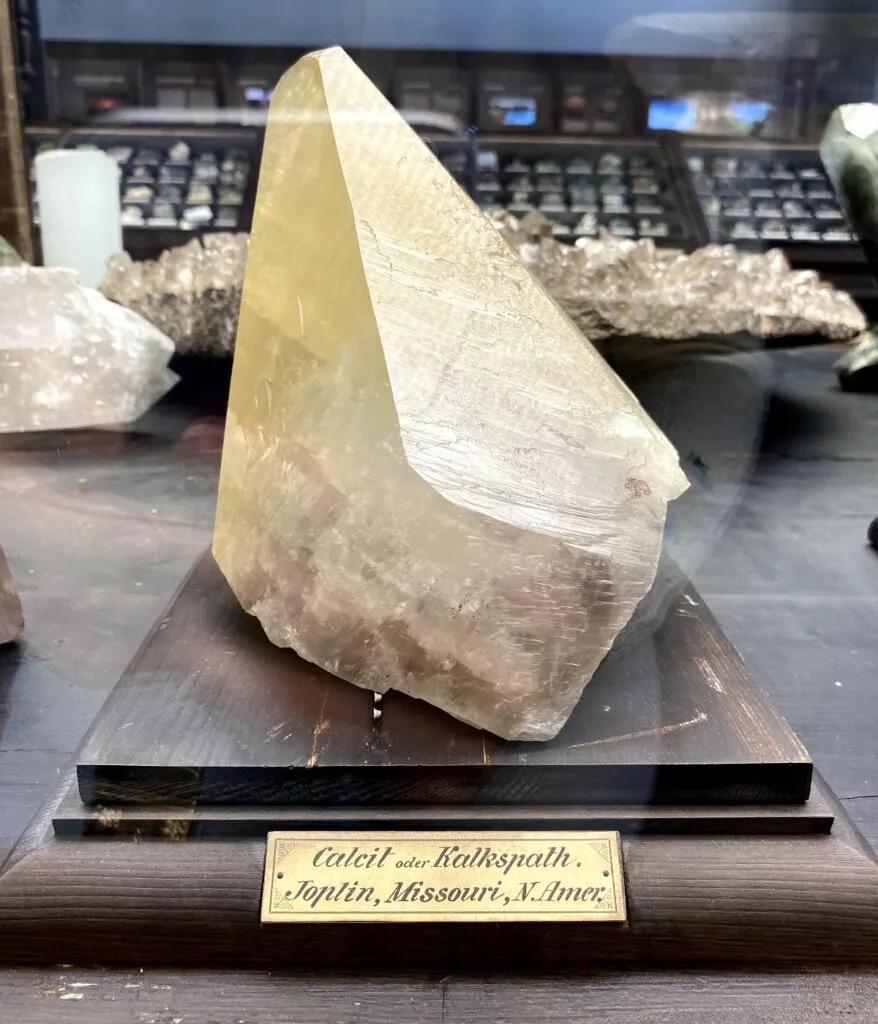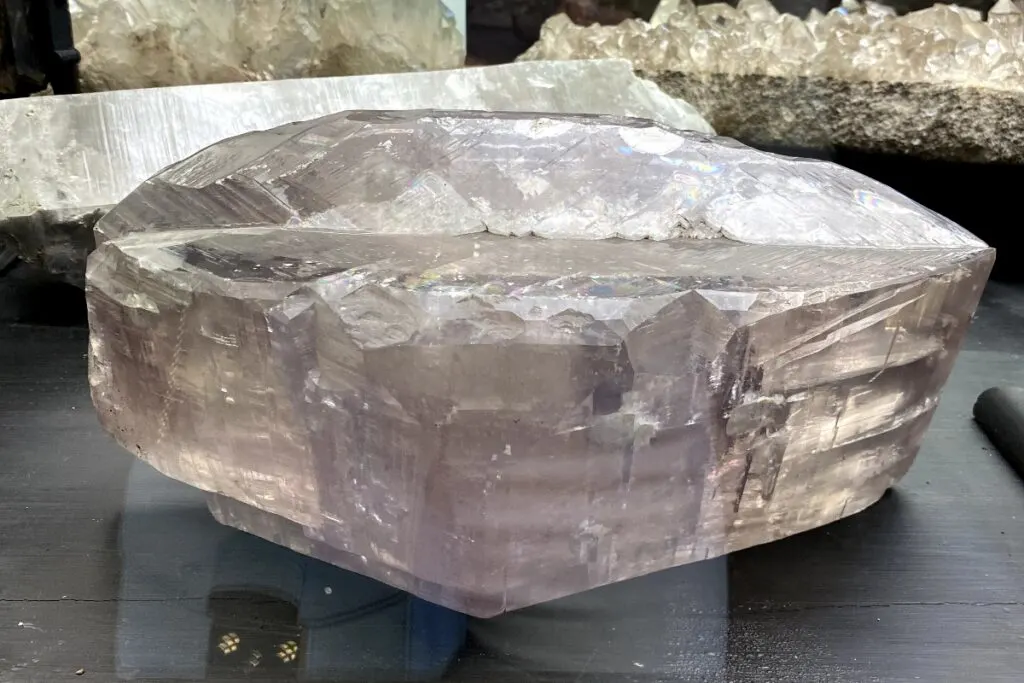As an Amazon Associate, I earn from qualifying purchases with no additional costs for you.
Calcite occurs in numerous colored and crystal habit varieties, ranging from $3 to $25,000.00 for a specimen. Calcite is one of the most widespread minerals which occur in a wide range of geological conditions. It is an aesthetically pleasing mineral for collection and an essential mineral in technologies and construction materials.
Calcite comes in various crystal habits and colors, resulting in a wide range of varieties with different values. The primary factors affecting calcite’s value are its crystal habit, color, visible optical phenomena, twinning, luminescence, and origin. Calcite prices range from $5 to thousands of dollars.
Calcite is an affordable mineral with unique features that can be observed at home. It exhibits visible double refraction (birefringence) and vibrant luminescent colors such as orange, yellow, white, green, blue, red, and pink. It also has perfect cleavage in three directions, making it an essential mineral in any collection. Anyone can have fun with calcite!

If you are interested in checking out the best books about rock and minerals identification you can find them by clicking here (Amazon link).
Is Calcite Worth Anything
Calcite occurs in different qualities; therefore, the price for calcite specimens varies dramatically. Calcite can have various optical phenomena (luminescence, double refraction) that can be easily observed, so it is valuable for geologists, mineralogists, mineral collectors, and mineral enthusiasts.
Calcite is essential in many areas of human and plant, and animal life, often in unexpected ways. Calcite is calcium carbonate Ca(CO3) – a mineral most invertebrate organisms use to construct their shells and complex parts.
Calcite is used as a building material, abrasive, agricultural soil treatment, construction aggregate, pigment, and pharmaceutical. You probably didn’t expect that in this article, but mineralogically speaking, Michelangelo’s ‘Pieta’ and ‘David’ are also made of calcite (Carrara marble).
The combination of various calcite colors and crystal shapes creates numerous varieties of calcite.
The first group is calcite varieties divided due to their color. Chemically pure calcite is colorless. Various chemical elements and sand or organic impurities change the color of calcite, creating a list of the following calcite varieties:
Optical calcite (Iceland Spar)
This type of calcite crystal displays an optical phenomenon called birefringence (double refraction). This strong birefringence causes objects viewed through a clear piece of calcite to appear doubled.
Cobaltoan calcite
This type of calcite is sometimes called cobalt-bearing and exhibits a vibrant fuchsia-pink color due to cobalt. This is one of the most valuable varieties of calcite.
Manganoan calcite
Like cobaltoan calcite, manganoan (manganocalcite or manganese-bearing calcite) is a variety of calcite that owes its pale pink color to elevated manganese concentrations.
The second group of calcite varieties is based on calcite crystal habit. Calcite has numerous habits (crystal forms). Habits include acute to obtuse rhombohedra, tabular habits, prisms, or scalenohedra.
Calcite exhibits several twinning types that add to the observed habits. Either calcite occurs as fibrous, granular, lamellar, or compact aggregates.
Dogtooth calcite
It is the most recognizable variety of calcite. The form of the Dogtooth calcite is created by a scalenohedral form of crystals and resembles a sharp dog fang.
Angel Wing calcite
It is a rare form of calcite, mainly originating from Mexico. It is named after the fragile flattened calcite crystals that, in the form of aggregate, resemble a white wing.
Poker calcite
Poker calcite is called so due to flat rhomboids that create a mineral specimen resembling a poker chip.
Popcorn calcite
Popcorn calcite is a variety of calcite that occurs in small white noodles.
And finally, sometimes you can come across a variety of calcite called Crazy calcite. This name is mainly confined to calcite samples from Franklin, New Jersey, USA, that exhibit a strong fluorescence of vibrant red color.
TIP: Geologists classify minerals based on various common characteristics depending on the sphere of geology in which the classification is used. Find out the complete guide in the article below:
How to Guide: Classification of Minerals by PRO Geologist
The Main Factors of Calcite Value

The main factors of calcite value are crystal habit, color, transparency, association with other minerals, presence of intense fluorescence, visible double refraction, special features like twinning or phantoms growth zoning, and sometimes the locality the calcite sample originates from.
There are the following calcite value factors that can significantly influence the price of calcite:
- Color
In the same way as color define the value of other minerals, it influences calcite value also. Even if chemically pure calcite is colorless, because of chemical impurities and inclusions, it can occur in various colors, where the most valuable are bright hues of pink, blue, green, orange, and yellow.
- Crystal habit
Calcite can be found in well-crystallized and defined shapes with minor damage. Crystal shapes, such as rhombohedrons or scalenohedrons, both short and long prismatic well-developed forms, are highly valued by collectors.
For example, Dogtooth and Angel wing varieties of calcite are called so because of their specific crystal habit.
- Transparency (clarity)
Transparency works the same way as usual in mineral value. Calcite crystals with fewer inclusions or impurities are often more valuable.
Especially in the case of calcite minerals, high transparency can make visible the double refraction (birefringence) optical effect, making a mineral sample more valuable as well.
- Mineral associations
Calcite intergrowth with other minerals can increase the value of a mineral sample. An aesthetically pleasing combination of calcite with emerald green dioptase or incrusted with golden chalcopyrite or contrasting samples with lazurite, galena, fluorite, or hematite.
- Fluorescence
Some calcite specimens glow under ultraviolet (UV) light, emitting different colors. Fluorescent calcite samples exhibiting vibrant red, orange, and blue colors are highly sought after.
Sometimes you can come across calcite variety with the name Crazy calcite. It means the same exhibit vibrant fluorescence.
- Location and origin
Due to their historical significance and scarcity, calcite specimens from well-known or historical mineral localities tend to be more valuable. For example, localities include Elmwood Mine, Tennessee, USA; Cave-in-Rock, Illinois, USA; Sweetwater Mine, Missouri, USA.
- Special features
Some other unique features contributing to calcite value are twinning phantoms (a growth pattern where a crystal grows within another crystal), visible double refraction (birefringence), or the cat’s eye phenomenon.
TIP: Generally, tumbling calcite isn’t necessary because even rough, it shows the mineral properties and markings. Find out more about tumbling calcite in the article below:
Can You Tumble Calcite? Be Careful and Follow These Tips!
How Much Is Calcite Worth

Common calcite of average quality (milky translucent) costs $5-10 per specimen. Depending on various factors, more valuable, well-formed calcite crystals cost from $50 to thousands of dollars. The price for faceted gem calcite ranges from $5 to 40 per carat, with a standard price of around $12 per carat.
Faceted calcite is quite rare, as calcite is one of the most difficult minerals to cut because of perfect cleavage in three directions.
However, the most proficient gem cutters do not stop trying to cut calcite because, in the faceted form, its high double refraction produces a very strong and mesmerizing play of color. The price for faceted calcite is very objective. Such gems are commonly sold by the piece.
Calcite Price per Pound, Ounce, Gram, Kg & Carat
Faceted gem calcite per carat price is around $12 ($60 per gram). Common calcite mineral specimens cost around $20-50 per 5 oz specimen, which recalculated will be $0.13-0.32 per gram, $4-10 per ounce, $64-160 per pound, and $130-320 per kilo. However, some valuable calcite sold for thousands of dollars.
The most expensive calcite available for purchase is a scalenohedron twinned specimen (Dogtooth calcite) with dimensions around 11 x 8 cm from Elmwood Mine, Carthage, Smith Co., Tennessee, USA, with the price of $25,000.00. Another expensive calcite specimen is cobalt-bearing (cobalton) calcite, up to $14,000.00.
As you can see from above, there are a lot of factors that influence calcite value. Therefore we decided to give a price for faceted stones separately from the price for mineral samples.
Table: Calcite price for different units.
| Weight units | Calcite price |
|---|---|
| per carat (ct) | $5 – 40, commonly around $12 for faceted calcite |
| per gram (g) | $15 – 200 for faceted calcite,$0.13-0.32 for crystal calcite* |
| per ounce (oz) | $4 – 10 for crystal calcite |
| per pound (Ib) | $64 – 160 for crystal calcite* |
| per kilo (kg) | $130 – $320 for crystal calcite* |
* recalculated based on the price per ounce
BTW: Do you want to know more about rock and mineral identification? The books listed below are the best ones you can find on the internet (Amazon links):
- Smithsonian Handbooks: Rocks & Minerals
- Gemstone & Crystal Properties (Quick Study Home)
- Ultimate Explorer Field Guide: Rocks and Minerals (National Geographic Kids)
Calcite Price by Color
Vibrant pink (cobaltoan) calcite price starts from $50 and reaches thousands of dollars. Colorless optical calcite (Iceland Spar) price is $30 to 500. Blue and green calcite price is about $20- 200. Orange and yellow calcite prices are about $10 to 100. The brighter the color, the more expensive the calcite is.
The prices in the table below are for calcite varieties based on color. However, the crystal form and other factors can significantly increase the value of calcite.
| Calcite color | Price range |
|---|---|
| Pink (cobaltoan) calcite | $50 – $500* |
| Colorless optical calcite (Iceland Spar) | $30 – $500 |
| Blue | $20 – $200 |
| Geen | $20 – $200 |
| Orange | $10 – $100 |
| Yellow | $10 – $100 |
*Thousands of dollars for museum-quality specimens
TIP: Real calcite is a very common mineral so it usually doesn’t have synthetic fakes. Anyway, check out the main differences between real and fake calcite in the article below:
Real vs. Fake Calcite: Focus on These 6 Differences
What is the Most Valuable Type of Calcite

The most valuable type of calcite is cobalt-bearing (cobaltoan) vibrant pink calcite, optical calcite or Iceland Spar (highly transparent variety of calcite), and cat’s eye calcite. Other valuable calcite types are blue, green, orange, and yellow. Calcite with intense luminescence is also highly valuable.
Where to Buy Real Calcite
It is safe to buy raw crystals of calcite everywhere. It’s better to buy valuable varieties of calcite from reputable sellers. Local mineral shops and mineral shows are good places to buy real calcite. Avoid buying tumbled and shaped into pyramids and spheres calcite crystals via online platforms.
BTW: If you are looking for the best UV light for rockhounding, find out my picks below (Amazon links):
- BEST OPTION: Convoy 8+ 365nm UV LED Flashlight with Patented Glass Filter
- BUDGET OPTION: Karrong Rechargeable 1200 Lumen 395nm UV Flashlight
- OPTION FOR INDOOR USAGE: Prime Upgraded Big Chip 396nm UV
Conclusion
There are numerous varieties of calcite based on color and crystal form. They are Optical calcite (Iceland Spar), Cobaltoan calcite, Manganoan calcite, Dogtooth calcite, Angel Wing calcite, Poker calcite, Popcorn calcite, Crazy calcite.
The main factors of calcite value are:
- color,
- crystal habit,
- transparency,
- association with other minerals,
- fluorescence,
- special features like twinning, phantoms growth zoning, and visible double refraction,
- the locality and origin of the calcite.
Prices for calcite range dramatically from first dollars for typical quality samples to dozens of thousands for museum quality species.
Common calcite of average quality (milky translucent) costs $5-10 per specimen. The price for faceted gem calcite ranges between $5-40 per carat, with a standard market price of around $12 per carat.
The most valuable varieties of calcite are optical calcite (Iceland Spar), vibrant pink cobalt-bearing calcite, and bright blue, green, orange, and yellow varieties.
TIP: Calcite is quite a widespread mineral that many rockhounds seek to have in their collection. Check out the best sites for finding calcite in the United States in the article below:
Where to Find Calcite: Best Environments & Locations (USA)
